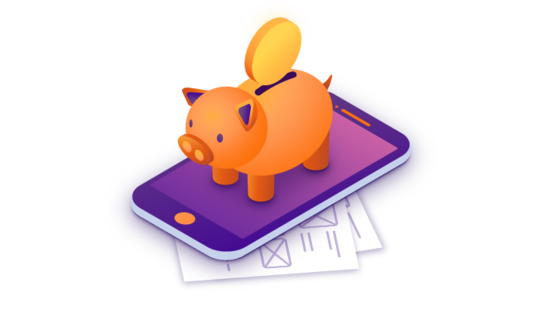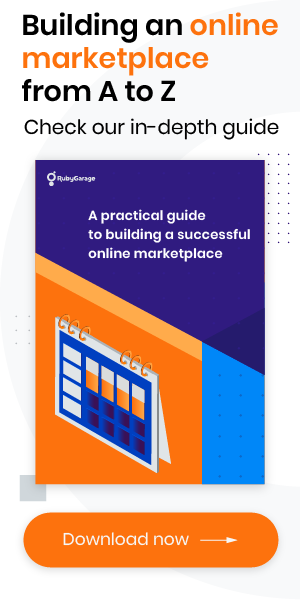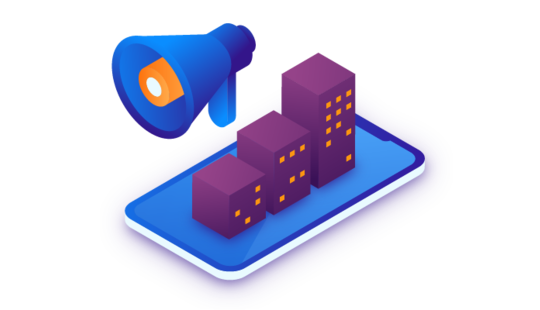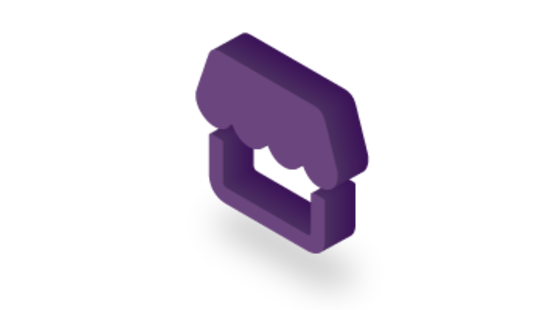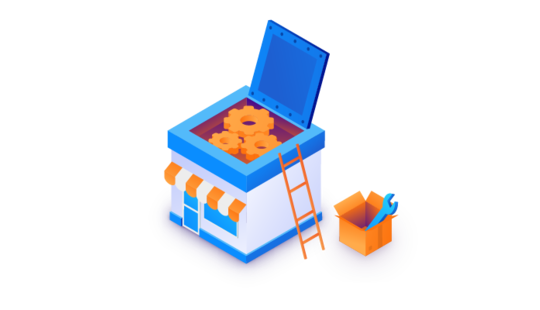-
Product Management
Software Testing
Technology Consulting
-
Multi-Vendor Marketplace
Online StoreCreate an online store with unique design and features at minimal cost using our MarketAge solutionCustom MarketplaceGet a unique, scalable, and cost-effective online marketplace with minimum time to marketTelemedicine SoftwareGet a cost-efficient, HIPAA-compliant telemedicine solution tailored to your facility's requirementsChat AppGet a customizable chat solution to connect users across multiple apps and platformsCustom Booking SystemImprove your business operations and expand to new markets with our appointment booking solutionVideo ConferencingAdjust our video conferencing solution for your business needsFor EnterpriseScale, automate, and improve business processes in your enterprise with our custom software solutionsFor StartupsTurn your startup ideas into viable, value-driven, and commercially successful software solutions -
-
- Case Studies
- Blog
How to Start a Crowdfunding Website Like Kickstarter
The unique value of crowdfunding isn‘t money, it’s community
When he started to build Kickstarter, founder Perry Chen was inspired by bringing ideas to life with the help of people. Several years of hard work and enthusiasm paid off in the form of an outstanding website and over $5 billion pledged to Kickstarter projects so far. But what is the secret of Kickstarter’s success and how can you create your own outstanding crowdfunding website? In this article, we shed light on how Kickstarter was created, reveal its business model canvas, and provide a time and cost estimate for a similar website.
What’s Kickstarter?
Kickstarter is a crowdfunding website where creators can raise funds to bring their innovative ideas to life. It all began in 2002, when Perry Chen, a cofounder of Kickstarter, wanted to organize a Kruder & Dorfmeister concert in New Orleans. The concert didn’t take place, but the Kickstarter idea was born. Perry came up with the concept to create a space where anyone could share their ideas with the public (for example, to organize a concert), and if other people liked the idea, they could pledge some money to help bring it to life.
For a long time, the idea remained just that — an idea. Then everything changed in 2007. That’s when Perry Chen met Charles Adler, a designer who offered to create a website. The work was finally completed in 2009, and in April of that year, three friends officially announced the launch of the Kickstarter website.
Since the launch of the Kickstarter website, 18 million people have backed projects, 18,000 of which have been successfully funded. These numbers are incredible. Let’s take a look at how Kickstarter evolved to achieve such success.
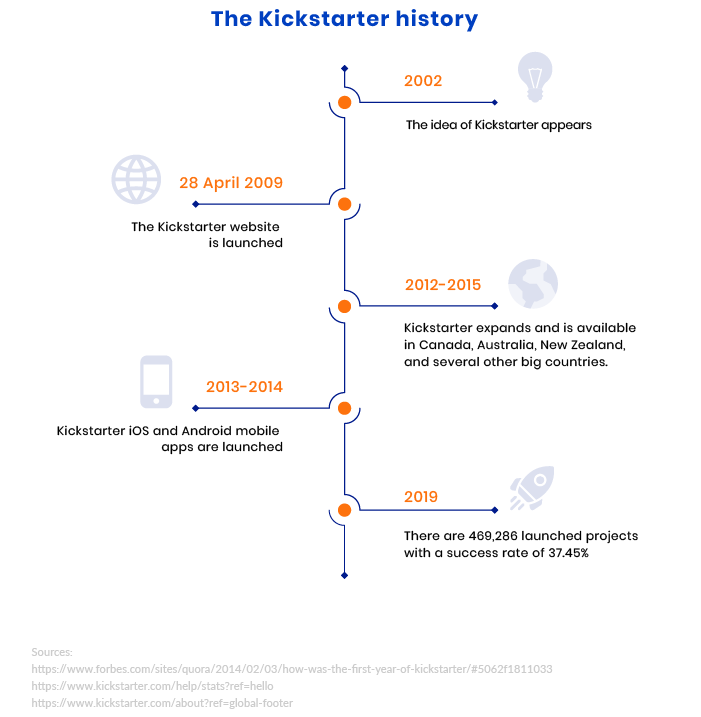
What makes Kickstarter special?
Kickstarter wasn’t the first crowdfunding website, but it brought powerful ideas to the crowdfunding sphere. Here are the main features that set Kickstarter apart from other websites.
All-or-nothing principle
Most crowdfunding websites work in such a way that when campaign creators set funding goals and don’t achieve them, they still keep the amount raised, even though it may not be enough for further development. This means donors may invest in projects with little chance of success.
To make sure donors help creators who have more chances to succeed, Kickstarter redefined the funding approach and offered a more reliable model. On Kickstarter, backers pledge a certain amount of money, but campaign creators can get it only if the total amount pledged reaches or exceeds the funding goal. Backers aren’t charged anything until a campaign is fully funded. This principle is called all-or-nothing. The campaign creator either receives the full amount to develop the idea further or leaves with nothing.
Kickstarter believes in creativity
If you look at the first page of projects on the Kickstarter website, you’ll notice that a lot of projects are related to art. Kickstarter expressly prohibits fundraising for charities, political campaigns, agricultural products, medical technologies, and non-inventive personal projects.
Ownership remains with the creator
Backers invest in projects for many reasons. They may decide to support a friend or just like a project and believe in the idea. But backers on Kickstarter aren’t investing to reap the benefits. On Kickstarter, ownership of an idea always belongs to the creator. In exchange for supporting ideas, backers receive rewards. Typically, rewards are limited editions of products or copies of creative works.
Kickstarter business model
If a project presented on Kickstarter has collected the set goal, the organization takes five percent of the total raised. Kickstarter also charges a commission of three to five percent (depending on the amount of the pledge) for each pledge received from backers.
Straightforward workflow
Kickstarter aims at building transparent relationships with the community. It offers a straightforward workflow that allows anyone to see how money is distributed, whether a fundraising campaign succeeds or fails. Let’s take a look how Kickstarter works:
- A creator makes a profile to demonstrate a product prototype or concept.
- The creator set a funding goal and a timeframe to collect that amount.
- To attract backers, the creator offers rewards.
- Once the funding goal is achieved, the creator receives the pledged amount to bring the project to life.
- If the funding goal isn’t achieved, backers aren’t charged and the creator doesn’t receive support.
Kickstarter business model canvas
To validate your business idea, you can use a business model canvas. Typically, a business model canvas is a one-page template where you indicate key aspects of your organization. This tool helps you focus on your target audience, the value your product can bring to users, and the way your company will make money. A business model canvas is a useful tool to validate your business idea, since you don’t need to spend a lot of time on it and can change it immediately if needed. To help you create a business model canvas for your own crowdfunding website, below, we share a complete business model canvas for Kickstarter.
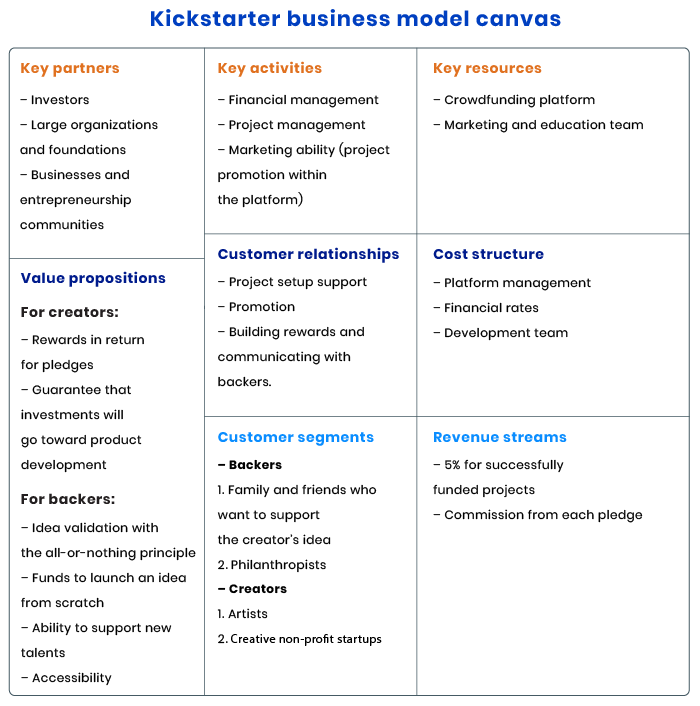
Feature set for a crowdfunding MVP like Kickstarter
When creating a website like Kickstarter, you need to attract both backers and creators. To provide all parties with the greatest user experience, it’s necessary to take into account the set of functionality required by backers and creators and provide an opportunity for conveniently transferring funds as well as tools to set up and launch campaigns. There are three types of users on crowdfunding website: administrators, backers, and creators. Below, we outline the feature sets for each type of user on a website like Kickstarter.
Feature set for administrators
Administrators expect features that allow them to moderate the entire website and manage creators, investors, and projects. Let’s take a look at the feature set that’s essential for administrators:
- Account management — Administrators should be able to filter and sort lists of creators and backers. They should also be able to deactivate user accounts in the event that users breach platform rules.
- Admin accounts — Each administrator should be able to log in to the system with their own account. Separate accounts help to determine which administrator made specific changes. This improves the transparency of the change history on the website so that changes may be reverted in case an admin makes a mistake.
- Project and category management — Administrators should be able to sort project lists, view project descriptions, and deactivate projects if they violate platform rules. Administrators should also be able to add or remove categories from the list.
- Investment and transaction management — Administrators should be able to sort and export transactions. In case of transaction errors, administrators should also be able to view payment details and report errors to users.
- Customer support — Admins should be able to manage and filter contact requests and should be able to view feedback from backers and creators.
Feature set for backers
When visiting crowdfunding website, backers want to find and support innovative ideas. Below are the main features that will make it easy for backers to invest in ideas they like:
- Registration — To make registration painless, allow backers to sign up not only with the help of email but also with Facebook, Google, Apple, or Twitter accounts.
- Authorization and accounts — Allow backers to log in to their accounts with an email and password, update their phone numbers, change passwords, and delete their accounts.
- Profiles — Backers should be able to select an avatar and provide brief information about themselves.
- Project exploration — Supporters should be able to view a list of categories and projects within these categories. They should also be able to study profiles of projects they like, which should contain detailed descriptions, videos, photos, and overviews of project risks and opportunities.
- Payments and investment settings — Backers should be able to choose payment methods, manage transactions, and get their money back if a project isn’t fully funded. Also, backers should be able to view their transaction histories and transaction details.
Feature set for creators
Help creators get funding for their ideas. Here are the features creators will need to present and manage campaigns.
- Registration — Creators should be able to register with the help of an email and password or using existing accounts in other systems like Google, Facebook, and Twitter.
- Authorization and accounts — Creators should be able to log in using an email or phone number and should be able to reset passwords.
- Profiles — Creators should be able to present information about themselves and their teams as well as add an avatar.
- Project management — Users should be able to create projects to raise money. When doing so, they should be able to add a project description, videos, photos, and business plans. This feature set allows creators to add or delete details about their campaigns to attract investment.
- Manage investments — Campaign creators should be able to view the details of pledges, see how much they’ve raised, and see if they’ve reached their goals.
How to build a crowdfunding website like Kickstarter
If you’re thinking of developing a website like Kickstarter, consider three development approaches: using a content management system, purchasing a white label solution, or developing your website from scratch. We explain the pros and cons of each approach below.
Open source content management system
A content management system (CMS) is open source software that allows you to create your product fast.
There are a lot of free and paid content management systems. However, only some of them are suitable for building a crowdfunding website. WordPress, for instance, is a CMS with which you can create a crowdfunding website. To make your website work, you’ll need to add a theme like IgnitionDeck or FundingPress to the WordPress CMS. To further expand the functionality of your website, you may also need to add some plugins.
Advantages of choosing a CMS approach
Attractive price. When choosing the CMS option, you’ll pay significantly less than if you bought a white label solution or created a website from scratch. The WordPress CRM is free, and you’ll only need to pay for the theme and plugins you use.
Frequent updates. Creators of paid themes and plugins are interested in attracting new and retaining existing users of their products. Since the competition between developers is high, creators improve their themes and plugins as often as possible. The upside is that updates are provided for you, so you don’t have to make changes yourself.
No need for deep coding skills. This method of building a crowdfunding website doesn’t require in-depth knowledge of coding. By using guides on WordPress, you can easily put together a crowdfunding website.
Disadvantages of choosing a CMS approach
Template solution. With all its advantages, a CMS has a narrow set of features for building a unique crowdfunding website. Using the same solutions as other similar websites, you won’t stand out and won’t be able to offer something new to attract users.
Precarious security. It’s important to note that WordPress has a high level of security. However, plugins and themes that you apply to your site can affect security. WPScan Vulnerability Database statistics show that 86 percent of WordPress website hacks are carried out because of the weak security of plugins or themes. These weaknesses can seriously affect the safety of users’ personal and financial data.
Hidden expenses. WordPress is free. You can also use free themes and plugins to build your crowdfunding website. This looks attractive at first glance, but free themes and plugins can’t satisfy all your business needs, since they have poor interface designs and aren’t secure. To build a feature-rich website with a CMS, you’ll need to pay for advanced themes and plugins. Bear in mind that you can’t buy them outright but will have to subscribe and pay a monthly or yearly fee. And in case you need a feature that your theme and plugins don’t provide, you’ll need to hire a developer or a designer. There’s a high probability you’ll spend more than you expected.
No ownership. When you subscribe to paid plugins and themes, you don’t own them. You just pay for the right to implement them on your website. This means you won’t have access to the source code and cannot make changes or fix errors yourself. The website you build with WordPress or any other CMS doesn’t belong to you to the hilt. Basically, you rent it for the time you use it.
White label solutions
A white label solution is a way of starting a website wherein business owners buy an almost complete crowdfunding website. When choosing this option, you get full ownership rights to your website’s source code. The only thing you need to do before releasing your site to the public is to choose the necessary feature set and brand it.
Advantages of choosing a white label approach
Quick market launch. A white label solution is well suited for those who want to quickly get to the market. Unlike developing a crowdfunding site from scratch, business owners can buy an almost ready white label solution and launch it in three to five months. When you purchase a white label product, you get a website with the most common and necessary set of features for a crowdfunding website. You can customize the site, add or remove any of these features, and hit the market with a quality website in a short period of time.
Full ownership. When buying a white label product, you get the source code of your website. This allows you to expand, modify, and refine your site as you want.
Disadvantages of choosing a white label solution
Can’t influence the technology stack. When opting for a white label solution, you can’t influence the development approach or choose a technology stack because the product already exists. If you have specific preferences for the tech stack you’d like your product to be built with, then it’s best to develop your crowdfunding website from scratch.
Development from scratch
Developing a website from scratch means you need to hire a team that will create your website from the ground up. When doing so, you can take part in every stage of product development and build a crowdfunding website with only the necessary features, a seamless user experience, and a branded user interface.
Advantages of choosing development from scratch
One-of-a-kind website. Development from scratch makes it possible to create a unique, user-friendly crowdfunding website tailored to your requirements and your brand. This can be a winning strategy for your business, as it will set your website apart from competitors’.
Perfect feature set. CMSs and white label solutions won’t cover the needs of your business if you want a non-template product. When developing from scratch, you choose the unique set of features you want and create a website that suits the needs of your market and your target audience.
Custom technology stack. Developing from scratch allows you to choose a feature set, technology stack, and team that follows the most modern development principles to create robust, clear, scalable, and secure code for your crowdfunding website. This approach also allows you to think through the site architecture so that in case of errors or code updates, developers can quickly understand what needs to be done.
Step-by-step development. When starting a website from scratch, you can first create a minimum viable product (MVP). This allows you to validate your idea and get feedback from real users. The feedback you receive will help you gradually develop your crowdfunding website to meet the needs and expectations of users and rapidly respond to market changes. Also, to launch an MVP, you’ll need only six to seven months, which ensures a short time to market.
Disadvantages of choosing development from scratch
Takes more resources. Compared to the other approaches, building a website from scratch takes more resources, most of which are spent on planning and gradual development. However, spending more time on planning and development gives you a chance to prevent errors, rework, and retesting.
The verdict
A white label solution or an open source CMS will help you save money and time. Nevertheless, when opting for one of these approaches, you risk getting a buggy, templated solution with little chance to stand out from the competition. Despite the higher cost and longer development time, building a crowdfunding site from scratch allows you to create a perfect match for your end users and business requirements.
How much does it cost to build a crowdfunding website like Kickstarter?
If you think that development from scratch is the perfect option for your crowdfunding website, then you’ll probably want to know the time and cost to create such a product. Below, we show time estimates for a website like Kickstarter, broken down by feature sets.
Administrator features
| Module | Hours |
|---|---|
| Account management | 33.5 |
| Authorization and accounts | 34 |
| Project and category management | 66 |
| Investment and transaction management | 44 |
| Customer support | 16 |
| Total hours | 193.5 |
Backer features
| Module | Hours |
|---|---|
| Registration | 195 |
| Authorization and accounts | 128 |
| Profiles | 84 |
| Project exploration | 145.5 |
| Payments settings | 187.5 |
| Investment settings | 310.5 |
| Total hours | 1050.5 |
Creators features
| Module | Hours |
|---|---|
| Registration | 237 |
| Authorization and accounts | 127.5 |
| Profiles | 84 |
| Project management | 319.5 |
| Manage investments | 159.5 |
| Total hours | 927.5 |
In total, developing an MVP for a crowdfunding website like Kickstarter takes around 2,171.5 hours.
To calculate the cost of development, you’ll need to know the cost of your team. It’s important to understand that the cost of software development teams varies and depends on the region the team is from and their level of expertise.
According to Clutch, the hourly rate in India varies between $15 and $25. If you hire a team in the United States, be ready to pay from $150 to $199 an hour. The hourly rates in Australia and Western Europe are slightly lower, ranging from $100 to $150. Eastern European developers charge between $25 and $50 an hour.
Based on the average cost and time required to create a website, we’ve calculated the maximum and minimum cost of a crowdfunding website.
| Region | USA | Western Europe and Australia | Eastern Europe | India |
|---|---|---|---|---|
| Minimum price | $325,725 | $217,150 | $54,287 | $32,572 |
| Maximum price | $432,125 | $325,725 | $108,575 | $54,287 |
Don’t make price the main criterion when choosing a development team, however. To get a high-quality product, you should also take into account such aspects as the quality of code the team provides, the maturity of the team’s workflow, and the qualifications, skill sets, and knowledge of specialists. Examine a provider’s previous work, look at their social media accounts, and study feedback from previous clients. The more you know about the development team you want to hire, the better the results you’ll get.
Team composition and schedule
Taking the previous estimate as the baseline, a team for developing a crowdfunding solution could look like the following:
| Team member | Quantity |
|---|---|
| Business analyst | 1 |
| UI/UX designer | 2 |
| HTML/CSS coder | 1 |
| Frontend developer | 2 |
| Backend developer | 2 |
| QA engineer | 1 |
With this team, you could expect delivery of a crowdfunding website in six to seven months.
Wrapping up
One of the most important challenges you face when developing a website like Kickstarter is selecting a highly qualified development team. Your choice of team will determine how user-friendly your product is, if it’s going to be stable and scalable, and if you can easily add functionality to it.
FAQ
-
Although Kickstarter wasn’t the first crowdfunding platform, it has become especially popular because it:
- Follows the all-or-nothing principle
- Promotes creativity
- Allows creators to maintain ownership of their projects
- Has a straightforward campaign flow
-
There are three main ways to build a crowdfunding website:
- Start a site with a content management system (CMS)
- Use a white label solution
- Build a website from scratch
-
Creating a website like Kickstarter takes around 2,172 hours. The cost of building such a crowdfunding platform ranges between $32,572 and $432,125 depending on the location and expertise of the development team.
If you’re looking for a professional development team to create a successful website, drop us a line.



